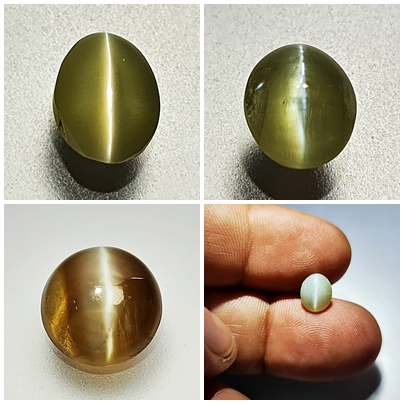
Chrysoberyl cat’s eye: Gemstone Information
Chrysoberyl Cat’s eye is the finest of its kind; while a number of other species may show eyes when appropriately cut, their eyes are far coarser and the flat back of many chatoyant specimens enables an RI test to be made. Chrysoberyl can be tested with the spectroscope. The name ‘cat’s eye’ is used on its own for chrysoberyl only, all other chatoyant stones needing the species to be used adjectivally. Occasionally a chrysoberyl will show a four-rayed star. The finest cat’s-eyes should show a very sharp blue-white eye against a dark honey-colored background.
While chrysoberyl cat’s eye is a characteristic mineral of granite pegmatites associated with mica schists or reaction zones in ultramafic rocks, gem crystals are found most often in placers. Brazil, long a producer of the best and brightest yellow-green chrysoberyl, has in recent years become the producer of magnificent alexandrite from the Lavra de Hematita field in Minas Gerais. The best material from this deposit equals or even surpasses alexandrite from the Takovaya emerald mines, north-east of Yekaterinburg [Sverdlovsk], Russia.
The color change is pronounced in the best alexandrite from both sources. Alexandrite was named in 1982 for Tsar Alexander II. Crystals are most commonly found as star-shaped twins (trillings) reaching 2 cm across in some examples. The host rock is a mica schist. Fine yellow chrysoberyl is found in the Sanarka district of the southern Urals though the best examples come from Jacuda, Brazil. Interesting small, included alexandrites but with a marked color change have been mined in Zimbabwe in the Smabula Forest area and from Lake Manyara, Tanzania.
A colorless chrysoberyl has been found in Myanmar and a faceted example forms part of the ACD Pain collection in the Natural History Museum, London. A brown specimen from a pegmatite in the Harts Range of central Australia gave an RI of 1.765, 1.772 and 1.777 and showed an intense absorption band in the violet center near 447 nm with another at 508 nm. Chrysoberyl has also been found at Anakie, Queensland. The finest cat’s-eyes are found in Sri Lanka though many commercial specimens are exported from Brazilian sources.
Title: Chrysoberyl Cat’s Eye: Unveiling Its Mystique and Benefits
Introduction: Chrysoberyl Cat’s Eye, a mesmerizing gemstone with a distinctive optical phenomenon, has fascinated gem enthusiasts for centuries. In this article, we’ll explore the origins, properties, uses, and the myriad benefits of Chrysoberyl Cat’s Eye, shedding light on its allure and significance in the world of gemstones.
Origins and Formation: Chrysoberyl Cat’s Eye is a variety of the mineral chrysoberyl, characterized by its chatoyancy or cat’s-eye effect, caused by the reflection of light on parallel inclusions within the stone. It forms in metamorphic and pegmatitic environments, typically in association with granitic rocks and deposits rich in beryllium. Chrysoberyl Cat’s Eye is primarily found in countries like Sri Lanka, India, Brazil, and Madagascar.
Properties: Chrysoberyl Cat’s Eye is renowned for its chatoyant band that resembles the slit-eye of a cat when viewed under focused light. This phenomenon, known as chatoyancy, is caused by needle-like inclusions of rutile or other mineral fibers oriented parallel to each other within the gemstone. Chrysoberyl Cat’s Eye typically exhibits a yellowish-green to brownish-yellow color and a vitreous to glassy luster. It has a Mohs hardness of 8.5, making it one of the hardest gemstones, suitable for everyday wear.
Uses and Applications: Chrysoberyl Cat’s Eye is highly valued in the world of gemstone jewelry for its unique appearance and mystical charm. It is often fashioned into cabochons to maximize the cat’s-eye effect and showcase its mesmerizing beauty. Chrysoberyl Cat’s Eye cabochons are commonly set into rings, pendants, earrings, and bracelets, both as standalone pieces and in combination with other gemstones. The gemstone’s durability and rarity make it a prized addition to any jewelry collection.
Metaphysical Properties and Benefits: Chrysoberyl Cat’s Eye is revered for its metaphysical properties, believed to bring luck, prosperity, and protection to its wearer. It is associated with the solar plexus chakra, enhancing confidence, courage, and self-expression. Chrysoberyl Cat’s Eye is said to promote clarity of thought, intuition, and spiritual awareness, helping individuals overcome obstacles and navigate life’s challenges with grace and resilience.
Furthermore, Chrysoberyl Cat’s Eye is believed to ward off negative energies and psychic attacks, creating a shield of protection around the wearer. It is also thought to stimulate creativity, abundance, and prosperity, attracting opportunities for success and fulfillment. Chrysoberyl Cat’s Eye’s calming energy is said to alleviate stress, anxiety, and emotional turmoil, promoting inner harmony and balance.
Caring for Chrysoberyl Cat’s Eye: To maintain the beauty and luster of Chrysoberyl Cat’s Eye jewelry, it is recommended to clean it regularly with a soft brush or cloth and mild soap and water. Avoid exposing the gemstone to harsh chemicals, extreme temperatures, and sudden impacts that may cause damage. Store Chrysoberyl Cat’s Eye jewelry separately from other gemstones to prevent scratching and abrasion.
Conclusion: Chrysoberyl Cat’s Eye stands as a testament to the wonders of nature, captivating hearts and minds with its enchanting beauty and mystical allure. Whether admired for its optical phenomenon, metaphysical properties, or symbolic significance, Chrysoberyl Cat’s Eye continues to inspire awe and fascination among gem enthusiasts worldwide. As we delve deeper into the mysteries of this extraordinary gemstone, we gain a deeper appreciation for its timeless elegance and enduring appeal.




